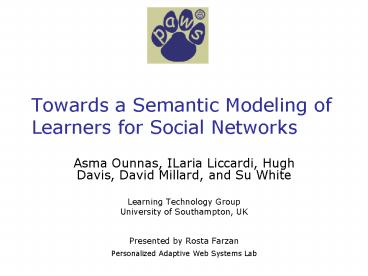Towards a Semantic Modeling of Learners for Social Networks - PowerPoint PPT Presentation
1 / 14
Title:
Towards a Semantic Modeling of Learners for Social Networks
Description:
Towards a Semantic Modeling of Learners for Social Networks ... Interest: hobbies and recreational. Relationship: between core data elements ... – PowerPoint PPT presentation
Number of Views:45
Avg rating:3.0/5.0
Title: Towards a Semantic Modeling of Learners for Social Networks
1
Towards a Semantic Modeling of Learners for
Social Networks
- Asma Ounnas, ILaria Liccardi, Hugh Davis, David
Millard, and Su White - Learning Technology Group
- University of Southampton, UK
- Presented by Rosta Farzan
- Personalized Adaptive Web Systems Lab
2
Introduction
- Social networks is important in distant learning
- Physically different location and different life
- Need friends who share same interests,
preferences, and learning experiences - Learner model
- Building social networks of learners
- This work
- An extension of Friend of a Friend (FOAF)
ontology to build learner model for social
networks
3
Outline
- Existing learner models
- Learners feature taxonomy
- Comparison of the learners model
- Extension of FOAF as a learner model
- Conclusion Future Work
4
PAPI
- IEE LTSC
- Data interchange specification
- Describes learner information for communication
among cooperating systems - Personal information
- General information e.g. name, address,
- 6 Categories
- Relations information
- Learners relationships with others e.g.
classmate - Security information
- Access rights
- Preference information
- Public information about the learners
preferences e.g. learning style, language, - Performance information
- Records of learners measure performance e.g.
grades - Portfolio information
- Learners projects and works
5
IMS LIP
- Similar to learner's CV
- Focus on Learners history and learning
experience - Lifelong model
- Transfer between institution
- 11 categories
- Identification name, e-mail,
- Goal Learning, Career,
- Qualification, Certification, License
- From recognized authorities
- Activity learning activities in any state of
completion - Interest hobbies and recreational
- Relationship between core data elements
- Competency skills and experiences
- Accessibility language capabilities, learning
preferences, disabilities - Transcript official academic achievements
- Affiliation organization
- Security Key password
6
eduPerson
- By Internet2 and Educause
- Facilitate communication between higher education
institution - Similar to employee information system
- Detailed description
- 43 elements in 2 categories
- General attributes
- Information about the learner, the organization,
and references - New attributes
- To facilitate collaboration between the
institution - E.g. Affiliation, ID for authentication,
7
Dolog LP
- By Dolog et al
- Uses RDF and learners ontologies
- For personalization services
- 5 categories
- Identification
- Name, telephone, address, email,
- Other user features
- Preferences, Goal, and Interests
- Study performance
- Performance, portfolio, and certification
- Human resource planning
- Organization
- Calendar
- Appointments and events
8
FOAF
- RDF vocabulary
- Properties and classes to describe
- People, documents, and organizations
- For building communities and social groupings
- 5 categories
- Basic information
- Name, email, images, homepage
- Personal information
- Weblogs, interests, publications
- Online accounts
- Projects and groups
- Projects, organizations
- Documents and images
- E.g. personal profile document, logo
9
Learners Features Taxonomy
10
Comparison of the Learner Models
11
Comparison of the Learner Models
- PAPI, LMS LIP, and Dolog PL
- Best for adaptive e-learning
- eduPerson
- Collecting data and transferring between
institution - FOAF
- Automatic personalization
- Describes learners relations with others by
pointing to learner knows
12
Comparison of the Learner Models
13
Extending FOAF
- Advantages of FOAF
- RDF
- 1.5 millions FOAF documents
- FOAF vocabularies evolves
- FOAF files are easy to create
- Facilitates locating people with similar interest
- Security and privacy issues are taken care
14
Extending FOAF
- Required feature for using FOAF as a learner
model - Personal Data
- Spoken and written language, gender, learning
styles, preferred modules - Relations
- Taking courses, taking module,
- Evaluating strength of the relationships between
learners - Algorithm for building social networks of learners































